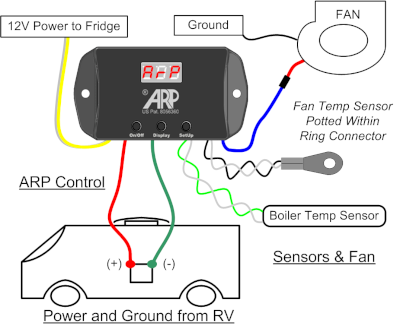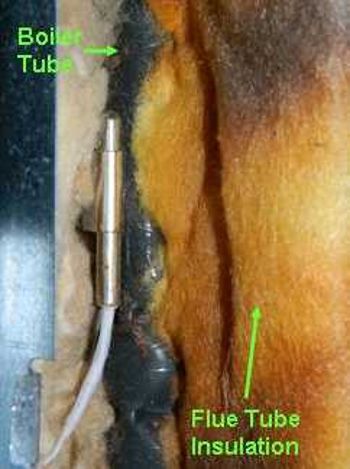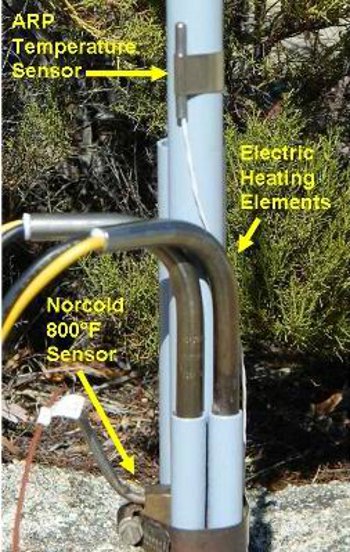This page is an installation overview of the Fridge Defend by ARP. Use the above Dometic or Norcold menus for installations on specific models of RV fridge.
Instructions: Subjects are listed on left. Click the link to the right to go directly to the subject matter on this page.
Previous to the introduction of the patented ARP Control, RV refrigerators had no monitoring of the cooling unit boiler temperature. Why monitor the boiler temperature? There are two reasons as follows:
SAFETY: All boilers, be it on a steam engine, a household heater, or your Dometic or Norcold fridge run at a constant temperature when everything is operating normally. When the "normal" boiler temperature rises, unsafe conditions arise due to excess thermal stress on the system. Most everyone has heard of a boiler explosion.
RELIABILITY: As described above, keeping the cooling unit boiler at safe levels also solves the main cause of Dometic and Norcold failure. Excess heat from the cooling unit boiler is the primary cause of failure for all RV refrigerators. Why go there? The small cost of the ARP Control could result in your fridge lasting the life of your RV.
Click for more on how Dometic and Norcold fridge fail due to the boiler overheating.When the ARP Control is installed correctly, it adds a level of safety to your fridge that was not available until the problem recognition, design, and resulting patent that became the Fridge Defend by ARP Control. It is important to leave the manufacture recall/safety devices in place. Most of these recall devices have been mandated by federal campaigns.
IS THE FRIDGE DEFEND by ARP HARD TO INSTALL:
Click this link for comments on IRV2 Forum dealing with this question.
REQUIRED TO DOWNLOAD INSTALLATION INSTRUCTIONS - WEB PAGES ARE SUPPLEMENTAL - EACH VERSION OF CONTROL HAS INTRICACIES REQUIRING THE WRITTEN INSTRUCTIONS.
This video shows the basic power wiring for Dometic or Norcold fridges with the Fridge Defend by ARP. Please note that the RV should have a 5 amp fuse on the circuit for the fridge:
1) Find and remove the fuse before working on your wiring.
2) If your fridge circuit has greater than a 5 amp fuse on the refrigerator circuit please put a 5 amp in-line fuse on the ARP red wire.

This diagram is a general installation guide for the Fridge Defend. This drawing shows the fan control version of the Fridge Defend.
The RV supplies power to the ARP via the red wire. In turn the ARP supplies power to the RV fridge controller via the yellow wire.
For the ARP without the fan control, just install the ARP temperature sensor in the cooling unit boiler housing on the boiler tube.
For the ARP with the fan control, in addition to the above steps, install the ARP fan temperature sensor (black/white wires) on the cooling unit absorber coil and wire the blower fan to the ARP fan control (blue wire).

Based on the operating principles, the temperature probe must be installed directly on the boiler tube.
This photo shows what the boiler looks like without the boiler housing on a Dometic DM2652.
The ARP temperature sensor may be installed through the heater access door on most refrigerators.
Please use the above menu for your make of fridge, be it a Dometic or Norcold, then use the next set of
menus to go directly to your model of fridge.
Even if your make and model are not shown, these pages are vary helpful
because all RV refrigerators are made in a similar fashion.
Click this link for the boiler sensor insulation instructions.

This photo is of a Norcold 1200 boiler. This is a boiler assembly that has been cut out of the cooling unit to help clarify the construction. Please note the following:
The ARP temperature sensor is clipped onto the boiler tube. The boiler tube is easy to identify because the electric heating elements are attached directly to the boiler tube.
Also note the Norcold 800°F sensor. More on this subject at this link: Norcold Very High Temperature Monitor
Any insulation, sheet metal or factory recall device MUST BE REINSTALLED.
Questions?
Please use the Contact Us form if you have any questions or comments.